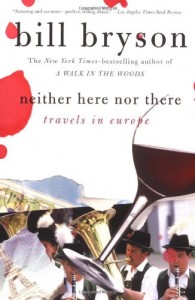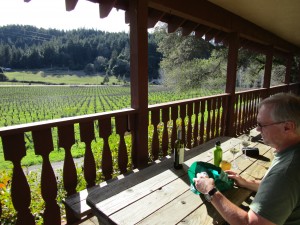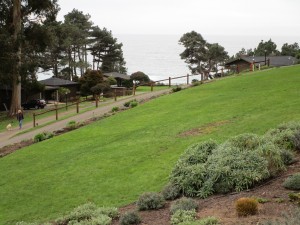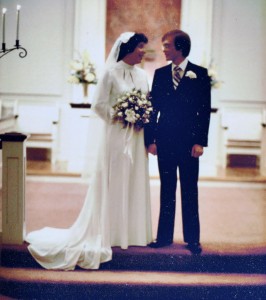How I Became a Rose Nerd
I was in Safeway, watching hapless men buy long-stemmed red roses for Valentines Day and silently cried “oh you poor guys, those aren’t real roses!”. But 20 years ago, that too was all I knew of roses. Then my mother gave me this little book and it changed everything. Therefore, the subtitle for this post is: It was all my mother’s fault.
 Once upon a time—before the 1860s—people loved old roses like “Baronne Prevost” “Marchionesse of Lorne,” or “Autumn Damask.” These were roses from the garden, richly scented and overflowing with petals. The trouble was once cut and arranged, the beautiful blossoms only lasted a few days — oh but those few days were a visual and perfumed delight. The artists of the time captured such lush rose arrangements even including their fallen petals.
Once upon a time—before the 1860s—people loved old roses like “Baronne Prevost” “Marchionesse of Lorne,” or “Autumn Damask.” These were roses from the garden, richly scented and overflowing with petals. The trouble was once cut and arranged, the beautiful blossoms only lasted a few days — oh but those few days were a visual and perfumed delight. The artists of the time captured such lush rose arrangements even including their fallen petals.
Then some enterprising nursery folks developed the hybrid tea roses (as in those long stemmed red roses at Safeway). These were easier to arrange (fewer thorns), more dramatic (brighter colors), and longer lasting (an arrangement of store-bought tea roses can last up to two weeks). But the saddest part of these new roses, was they had no scent…highly scented roses tended to be more delicate and less sturdy. So they bred the scent right out of these florist favorites. As so the old roses were all but forgotten.
But as In Search of Lost Roses tell us, these gently-hued, richly perfumed old roses made a comeback, thanks to the efforts of a crew of eccentric characters who rescued them from back alleys, ramshackle cottages, and overgrown graveyards across the country. Mr. Christopher recounts the fascinating stories of the old roses—how they were created and named—and the unforgettable people who saved them. We go from Texas to California to the American South to visit the interesting people who love and search for lost roses. It’s pure adventure as we join a group of “rose rustlers” as they sneak into secreted walled gardens, tramp through abandoned lots, climb over fences and visit forgotten cemeteries all in an effort to take and propagate cuttings from these old roses.
We meet the famous British old rose experts (Graham Thomas and David Austin*) and learn of how American pioneer wives brought rose cuttings from their far-away homes, lovingly keeping them damp during the journey. Even the rose nomenclature is full of politics, lost loves and secrets. Mr. Christopher’s discussion of rose genetics and propagation was fascinating – well at least to this rose geek. “Heritage’ or ‘heirloom’ roses are defined as those bred before 1867. No two old roses are alike – they come in all shapes – flattened, quartered petal formation, cupped or “overblown as a crinoline petticoat”. I devoured this book, taking notes, and reading bits aloud to my husband who just stared at me quizzically.
Turns out a major hub of old rose fanatics is here out west, where old roses came out with the Gold Rush and were planted around the miners shack doorways, in parks and at loved ones gravesides. When I closed the book I had a list and my mission was clear must — have — these —roses.
My first trip was to the Celebration of Old Roses just across the Bay.
 I stopped short, here was a huge room filled with old roses of every color, size, type — and readers — the scent was intoxicating – my idea of heaven on earth. Every rose was identified and categorized — China, Moss, Portland — (I could go on but I’ll save you the yawns). I took notes, talked to growers, got advice for my garden (ocean facing, high winds -not great for most roses but with these hardy old roses, I had a chance), and bought my first old rose bush Monsieur Tiller. I met the celebrities of the old rose world – Miriam Wilkins and the infamous Barbara Worl invited me to visit her garden in Palo Alto during the coming month. I came home happy, exhausted and full of plans. My poor husband quietly mentioned, “but I thought we have a drought resistant garden, roses need a lot of water you know”…I turned a deaf ear and secretly vowed to take shorter showers.
I stopped short, here was a huge room filled with old roses of every color, size, type — and readers — the scent was intoxicating – my idea of heaven on earth. Every rose was identified and categorized — China, Moss, Portland — (I could go on but I’ll save you the yawns). I took notes, talked to growers, got advice for my garden (ocean facing, high winds -not great for most roses but with these hardy old roses, I had a chance), and bought my first old rose bush Monsieur Tiller. I met the celebrities of the old rose world – Miriam Wilkins and the infamous Barbara Worl invited me to visit her garden in Palo Alto during the coming month. I came home happy, exhausted and full of plans. My poor husband quietly mentioned, “but I thought we have a drought resistant garden, roses need a lot of water you know”…I turned a deaf ear and secretly vowed to take shorter showers.
My next trip, suggested by Mr. Christopher’s book was here.
 The Sacramento Historic City Center Cemetery. Leaving home at the crack of dawn (not my finest hour), I joined a rose tour of the cemetery during which we were allowed to take a few cuttings. Then a workshop on starting roses from these cuttings -their technique uses zip-lock bags with soil, proper number of days closed and open, then you monitor the root growth …wow sorry — I started to geek-out there.
The Sacramento Historic City Center Cemetery. Leaving home at the crack of dawn (not my finest hour), I joined a rose tour of the cemetery during which we were allowed to take a few cuttings. Then a workshop on starting roses from these cuttings -their technique uses zip-lock bags with soil, proper number of days closed and open, then you monitor the root growth …wow sorry — I started to geek-out there.
Soon I was happily starting roses from cuttings “obtained” on our trips. Click on photos to make larger
A climbing rose from an ocean front lodge in Mendocino 
 A ‘found rose’ from a roadside in Croatia.
A ‘found rose’ from a roadside in Croatia.
 I have many David Austin Roses – here’s one of my favorites – James Galway
I have many David Austin Roses – here’s one of my favorites – James Galway
And like all rose nerds enthusiasts, I mess around for hours arranging my cut roses and then walking by just to smell and admire them.
And so the tale is told, this is the little book that started it all 20 years ago. Both the back and front gardens boast old garden roses and the deck has potted roses struck from cuttings I’ve rustled.
My name is Book Barmy and I’m a rose nerd.
But all geekiness aside, I dare you to read In Search of Lost Roses and not come away wanting at least one old rose for your garden.
Warning, I have another rose book to share with you at a later date — now that will keep you coming back.
* David Austin has developed a modern collection of old garden roses which are disease resistant, repeat blooming and have divine scents. I have many of his lovely roses. For some idea of their beauty click HERE
Neither Here Nor There by Bill Bryson
 I was in need of a book that would give me an escape and make me laugh. That’s when I’m grateful for Bill Bryson.
I was in need of a book that would give me an escape and make me laugh. That’s when I’m grateful for Bill Bryson.
Neither Here nor There is a book I keep to re-read in just such circumstances and when I opened it again the other day — it did the trick — I immediately started to giggle.
From the back cover:
Like many of his generation, Bill Bryson backpacked across Europe in the early seventies — in search of enlightenment, beer, and women. Twenty years later he decided to retrace the journey he undertook in the halcyon days of his youth. The result is Neither Here Nor There, an affectionate and riotously funny pilgrimage from the frozen wastes of Scandinavia to the chaotic tumult of Istanbul, with stops along the way in Europe’s most diverting and historic locales.
Mr. Bryson starts his mid-life crisis journey in Hammerfest, Norway (as far north as you can get in the world by public means of transport, he says) and re-traces his 1970 trip through Europe encountering language barriers, seedy train station hotels and delightful characters along the way.
I could quote this book for pages but will restrain myself to my favorites, get your hands on a copy and find your own:
The best than can be said for Norwegian television is that it gives you the sensation of a coma without the worry and inconvenience.
Romans park their cars the way I would park if I had just spilled a beaker of hydrochloric acid on my lap.
In the evening, I went looking for a restaurant. This is often a problem in Germany. For one thing, there’s a good chance that there will be three guys in lederhosen playing polka music, so you have to look carefully through the windows and question the proprietor closely to make sure that Willi and the Bavarian Boys won’t suddenly bound onto a little stage a half-past eight. It should have been written into the armistice treaty that the Germans would be required to lay down their accordions along with their arms.
The problem is that the pedestrian cross lights (in Paris) have been designed with the clear purpose of leaving the foreign visitor confused, humiliated, and, if all goes according to plan, dead.
She gave me one of those impassive Gallic (as in French) shrugs – the kind where the chin is dropped to belt level and the ears are pushed to the top of the head with the shoulders. It translates roughly as ‘Life is a bucket of shit, monsieur, I quite agree, and while I am prepared to acknowledge this fact I shall offer you no sympathy because monsieur, this is your bucket of shit’.
As you may have now surmised, Mr. Bryson is not afraid to be politically incorrect (he calls France’s population ‘Insufferably French) but he is also a devoted traveler and relishes the wonder and beauty of other cultures and lands.
One of the small marvels of my first trip to Europe was the discovery that the world could be so full of variety, that there were so many different ways of doing essentially identical things, like eating and drinking and buying movie tickets.
I arose each morning just after dawn, during that perfect hour when the air still has a fresh, unused feel to it, and watch the city (Rome) come awake — whistling shopkeepers sweeping up, pulling down awnings, pushing up shutters.
The Thomas Cook European Timetable is possibly the finest book ever produced. It is impossible to leaf through its five hundred pages of densely printed timetables without wanting to dump a double armload of clothes into an old Gladstone and just take off. Every page whispers romance: Montreux-Zweisimmen-Spiez-Interlacken or perhaps Beograd-Trieste-Venezia-Verona-Milano. Who could recite these names without experiencing a tug of excitement? Who could glance at such an itinerary and not want to climb aboard? (Sadly, this guide is no longer published or even on-line – they went out of business in 2013.)
This re-read made my travelers feet itchy. Mr. Byrson travels with open eyes, a sense of adventure, child-like wonder and a marvelous sense of humor. A required skill set for every traveler.
N.B. Neither Here nor There is also educational, you’ll learn important facts about each country. For example, did you know that Liechtenstein is the world’s largest producer of sausage skins and dentures?
N.B.2 Stay tuned, we’re planning a trip to Switzerland …hmm perhaps this itinerary — Montreux-Zweisimmen-Spiez-Interlacken
My Uncle Bob
(this is Bob, on the right, with my husband in Muir Woods several years ago.)
Those are tough words to write…but having suffered the ravages of Alzheimer’s, the doctors tell us Bob is in his last days.
Connie — his lover, partner, best friend and wife has been with him every step of this horrible journey and she is steadfast with him even now — holding his hand, caressing his brow and giving him the little snippets of love he can still understand.
His son has been at his side, his sister (my mother) has reminisced with him almost daily about their childhood memories, friends and neighbors call in to discuss sports or his beloved dogs, but now there is nothing more to be done. It’s just a matter of time — so they say. Bob stopped eating and taking liquids days ago. Many have weighed in and pray he will go quickly rather than suffer any more — but I wonder.
Why is he still here?
I think Uncle Bob is hanging on – because he feels the enormous love surrounding him. Why not struggle to stay here in this world just a little bit longer? Why not, despite all odds, stay with his most beloved — just to feel those moments of connection -and perhaps even happiness?
None of us know what the dying feel in their last days, but I hope they know the love of all their cherished ones, both present and past, who surround them at the end.
Maybe Uncle Bob isn’t actually suffering as much as he is clinging to the world he just can’t say goodby to – at least not yet – no not quite yet OK?.
I love you Uncle Bob.
My Salinger Year Joanna Rakoff
 Lets be clear, this is not a memoir specifically about J. D. Salinger, nor another sordid tale of having had an affair with him (thank goodness)–this is a memoir of a young woman working at his literary agency in the mid 1990’s.
Lets be clear, this is not a memoir specifically about J. D. Salinger, nor another sordid tale of having had an affair with him (thank goodness)–this is a memoir of a young woman working at his literary agency in the mid 1990’s.
Alright I can hear your yawns from here, but I’m always interested in the inner workings of the publishing industry and so I decided to read this memoir by Joanna Rakoff.
It’s the mid 1990’s and Joanna is 23 years old, and much like in The Devil Wears Prada, she really has no experience or interest in publishing but is thrilled to land an “assistant” position at a literary agency – referred to as “The Agency”. This is one of those classy but underpaid positions that presumably one can brag about at dinner parties. Ms. Rakoff has never read anything by Salinger and she thinks when agency staff refer to “Jerry”, their star client, they mean Jerry Seinfield. In fact “Jerry” is their code name for J. D. (Jerome David) Salinger, the notoriously reclusive author.
This is an old-school literary agency. Here is a world of richly carpeted offices, no overhead florescent lighting — just shaded lamps, messengers, martini lunches and book-shelved lined hallways. Computers are only whispered about by the staff.
Joanna is given strict orders to never give out any information on Salinger and the agency must protect his privacy at all costs. Joanna’s main job is to answer Salinger’s many fan letters with a simple but curt form letter:
“Dear ___________
Many thanks for your recent letter to J.D. Salinger. As you may know, Mr. Salinger does not wish to receive mail from his readers. Thus, we cannot pass your kind note on to him. We thank you for you interest in Mr. Salinger’s books.
Best, The Agency”
Her boss insists that Joanna type these letters out individually on a Selectric typewriter (using carbon paper) in order to give the fans a sense that an actual agency person has written back to them. Joanna must also answer her boss’s phone and if “Jerry”calls she is to keep it short and take a detailed message.
Joanna’s personal life is a mess, she lives with a ghastly boyfriend in a run-down apartment with no heat or a kitchen sink (?). She has, for no explanation, left the guy she really loves and he fled to California. Her parents have presented her with all her college bills unexpectedly unpaid and used her credit cards to rack up debt that Joanna must some how pay down. She’s broke financially and in her heart, so the agency is her only solace as Joanna is a lover of books, an avid reader and an aspiring poet.
There’s this lovely quote
On authors: The strange wonder of powerful writing, engaged in like some act of reflective devotion, and then, sent out, as on the wind, to find some home with unknown readers who in turn receive this revelation and transformation. Literature not as `escape’, literature as engagement.
It’s fun when Joanna steers away from the standard form letter and tries writing personal letters to the Salinger fans – with disastrous results. She hopes to become an agent and dips into the agency slush pile, finds an unknown author and tries to get her published. Also in the end, Joanna actually meets Salinger when he make a rare appearance at the agency offices.
That, my friends is about all that was interesting about this memoir. I’ve just saved you the chore of reading it yourselves. I did find some interesting parts about the inner workings of a literary agency – especially the care and feeding of Salinger himself. The grand event of finally getting one office computer for everyone to share was amusing and there’s some sly literary name dropping. This memoir covers a entire year of Ms. Rakoff’s life and it felt equally long to make it through this slow and overly-detailed story. One of the professional reviewers mentioned that this memoir started out as a much shorter magazine story and perhaps it should have stayed in that form.
Advanced review copy provided by Alfred A. Knopf
Same Time Next Year
Remember this? Click HERE
We just returned from the Heritage House Resort on the Mendocino coast where Same Time Next Year was filmed. This poor property has been through several owners since it foreclosed back in 2008. It finally re-opened, newly renovated, a couple of years ago and we’ve been wanting to stay there ever since. Our anniversary on Tuesday seemed the perfect excuse.
And now with apologies to family and friends back East, here are some photos — click to make larger.
Pay no attention to the short sleeved shirts and sunshine…OK?
 On the way to Mendocino, we had a picnic lunch at a favorite vineyard in Anderson Valley.
On the way to Mendocino, we had a picnic lunch at a favorite vineyard in Anderson Valley.
 The view from our cottage. Second cottage down below on the left is where Same Time Next Year was filmed. BTW, they run the film nonstop on the TV’s in the rooms.
The view from our cottage. Second cottage down below on the left is where Same Time Next Year was filmed. BTW, they run the film nonstop on the TV’s in the rooms.
Glorious sunset from our deck.



 A hike the next day took us from the coast into pygmy forest and coastal woodland.
A hike the next day took us from the coast into pygmy forest and coastal woodland.



 Next morning we strolled around the 40+ acres that make up these beautiful grounds.
Next morning we strolled around the 40+ acres that make up these beautiful grounds.



 Then a lovely drive home down Route 1.
Then a lovely drive home down Route 1.
Even saw sea lions. Click to make larger.
Happy Anniversary to my better half…let’s do this again, same time next year and every year after, OK?
circa 1979
The Great British Baking Show
 I first learned about this British show from one of my favorite book blogs: Stuck in a Book. Between book blogging, Simon has done recaps of every show airing in the U.K. The recaps were fun, but not having seen the show I couldn’t really understand the UK obsession –
I first learned about this British show from one of my favorite book blogs: Stuck in a Book. Between book blogging, Simon has done recaps of every show airing in the U.K. The recaps were fun, but not having seen the show I couldn’t really understand the UK obsession –
until now…
Produced in the UK under the name The Great British Bake Off, The Great British Baking Show is now airing on PBS. After watching the opening episode (the show airs just before Downton Abby) I must confess — I’m hooked.
I’m not a fan of competitive cooking shows — here in America they tend to be glaringly star-studded, overly wrought and focused on the competition versus the actual food. They contrive to whip the contestants into hysteria and seem to encourage unnecessarily ruthless competition. Ugh, count me out.
So I was surprised to find myself both enthralled and charmed by this program. The Great British Baking Show takes place in a huge white tent oddly planted in the park at Downton Abbey. (The Earl and Countess of Highclere – the real Downton Abby – are certainty cashing in.)
The judges are the two pictured here, Paul and Mary, and there are two sidekicks, Mel and Sue who give instructions to the contestants with cringe-worthy puns. The competitors range in age (the youngest is 17), occupation (there’s a builder/contractor) and appearance (a few clearly lack a good dental plan) and yet, they are all very endearing.
The judges don’t overwhelm in these programs, they let the contestants and their baking shine as the stars of the show. Mary is especially kind while Paul can border on pedantic. The show is reserved, not frantic, and the drama is low-key but addictive. Even during the Baked Alaska challenge when their ice cream centers were melting in the heat of the tent, the contestants (with the exception of one poor guy) remained calm and collected.
There is a delightful British wit and charm throughout. Each challenge is given with a cheery “on your marks, get set, bake” and the judges advise the contestants with typical British understatement –“bakers need to be vigilant…”
This is a kinder, gentler cooking competition. There is a naturalness between contestants and judges. All the contestants smile genuinely when the others get accolades and each departing contestant gets hugs from both fellow contenders and the judges. This program actually cares about the baking process and respects the contestants as craftspeople.
Happily the recipes have been converted to American cooking measurements and temperatures (no need to convert “gas mark 6”) and can be found HERE.
See if you can view the shows from the beginning – via on-demand or on-line HERE – so you can watch the progress of each contestant, and if you’re like me you’ll find yourself rooting for all of them equally.
N.B.: Each contestant has their own cooking station equipped with stoves that have a clever slide away door that drops down and then slots out of the way underneath the oven — preventing those nasty shin bruisings –I want one!










